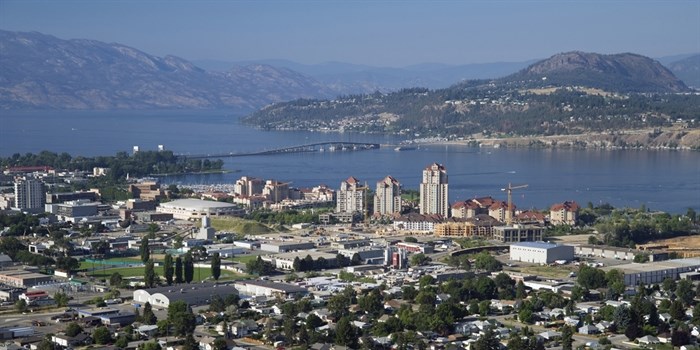
Kelowna, West Kelowna and Okanagan Lake are pictured in this stock image.
Image Credit: Shutterstock
November 07, 2017 - 11:30 AM
KELOWNA - Climate change was top of mind for Kelowna mayor and council yesterday as they dealt with the fallout from this year's weather extremes.
At its meeting Monday, Nov. 6, council addressed a trio of agenda items about the cost of recovery from this spring’s freshet and flood, as well as predictions of how the weather extremes of 2017 also caused drought and a costly wildfire season will become more frequent.
It started with a special community trends report called A Changing Climate: Special Edition delivered by planner Ross Soward, because nothing gets your attention like a one-in-two-hundred year flood that causes over $10 million in damage to civic infrastructure, followed swiftly on the heels by a major fire season that had the Central Okanagan Emergency Operations Centre open for 131 consecutive days.
"Although these extreme weather events cannot be said to have been caused by climate change, projections for the region show that the climatic trends for the region will make these extreme weather events more frequent and more severe in the future,” Soward told council.
Soward says the city is already adapting to climate change and key actions include support for the Mission Creek restoration initiative, protection of agricultural land and riparian areas as well as updating the wildfire protection plan and the development of a community climate adaptation strategy.
Council had no choice but to agree to the next agenda item which was the bill for the flood recovery, pegged at $10.5 million, but offset by provincial disaster relief assistance which should drop the final bill to just under $3.3 million.
Then focusing on Mill Creek, one of the hardest hit areas during the flood, senior infrastructure engineer Ron Westlake told council the city is applying for flood mitigation funding to complete flood mapping of the creek which enters Okanagan Lake beside the Bennett Bridge.
Risk manager Lance Kayfish says the city has been considering the potential effects of climate change for a long time, and that is reflected in the city’s Official Community Plan and subdivision bylaws.
However, the last few years have seen the predictions of climate change effects become a reality, he says.
“There is no question we have seen annual moisture similar to the traditional historic annual moisture levels but we’re finding it’s coming in larger doses, more infrequently,” Kayfish says. “This absolutely has an impact on infrastructure.
If there is a problem, Kayfish says it's not knowing how long climate change could last.
“Nobody has the perfect answer to this,” he says. “Are we going to shift back to the way things were have generally been for the last century after say a ten-year period of this or could it continue for much longer, we don’t know for sure.”
If money was no object, Kayfish says the city could easily build infrastructure such as storm sewers, docks and beachfronts that could withstand a one-in-one-thousand year flood.
“We could build hardened infrastructure like that, overbuild everything but I don’t think anyone would want to pay for that through their taxes or the investment they would still have to make to protect their own property,” he says.
To contact a reporter for this story, email John McDonald or call 250-808-0143 or email the editor. You can also submit photos, videos or news tips to the newsroom and be entered to win a monthly prize draw.
We welcome your comments and opinions on our stories but play nice. We won't censor or delete comments unless they contain off-topic statements or links, unnecessary vulgarity, false facts, spam or obviously fake profiles. If you have any concerns about what you see in comments, email the editor in the link above.
News from © iNFOnews, 2017